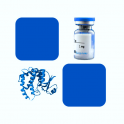
- Remove this product from my favorite's list.
- Add this product to my list of favorites.
Products
Newsletter
 |  |  |  |  |  |

Background
Noggin is also known as NOG,SYM1, SYNS1 and is a secreted homodimeric glycoprotein whose scaffold contains a cystineknot topology similar to that of BMPs.Secreted Noggin probably remains close to the cell surface due to its binding of
heparincontaining proteoglycans.Noggin inhibits TGF-β signal transduction by binding to TGF-β family ligands and preventing
them from binding to their corresponding receptors. Noggin plays a key role in neural induction by inhibiting BMP4, along with
other TGF-β signaling inhibitors such as chordin and follistatin. Mouse knockout experiments have demonstrated that noggin
also plays a crucial role in bone development, joint formation, and neural tube fusion. During embryogenesis, Noggin
antagonizes specific BMPs at defined times, for example, during neural tube, somite and cardiomyocyte growth and patterning. During skeletal development, Noggin prevents chondrocyte hyperplasia, thus allowing proper formation of joints. During culture of human embryonic stem cells (hESC) or neural stem cells under certain conditions, addition of Noggin to antagonize BMP activity may allow stem cells to proliferate while maintaining their undifferentiated state, or alternatively, to differentiate into dopaminergic neurons Noggin also appears to maintain adult stem cell populations in vivo, for example, maintaining neural stem cells within the hippocampus.
Source
Recombinant Human Noggin, Fc Tag (NON-H5257) is expressed from human 293 cells (HEK293). It contains AA Gln 28 - Cys 232 (Accession # Q13253-1).
Predicted N-terminus: Gln 28
It is produced under our rigorous quality control system that incorporates a comprehensive set of tests including sterility and endotoxin tests. Product performance is carefully validated and tested for compatibility for cell culture use or any other applications in the early preclinical stage. When ready to transition into later clinical phases, we also offer a custom GMP protein service that tailors to your needs. We will work with you to customize and develop a GMP-grade product in accordance with your requests that also meets the requirements for raw and ancillary materials use in cell manufacturing of cell-based therapies.
Molecular Characterization
This protein carries a human IgG1 Fc tag at the C-terminus.
The protein has a calculated MW of 49.5 kDa. The protein migrates as 55-60 kDa under reducing (R) condition (SDS-PAGE) due to glycosylation.
Endotoxin
Less than 0.1 EU per μg by the LAL method.
Sterility
The sterility testing was performed by membrane filtration method.
Mycoplasma
Negative.
Purity
>95% as determined by SDS-PAGE.
Formulation
Lyophilized from 0.22 μm filtered solution in PBS,pH7.4 with trehalose as protectant.
Reconstitution
Please see Certificate of Analysis for specific instructions.
For best performance, we strongly recommend you to follow the reconstitution protocol provided in the CoA.
Storage
For long term storage, the product should be stored at lyophilized state at -20°C or lower.
Please avoid repeated freeze-thaw cycles.
This product is stable after storage at:
-20°C to -70°C for 12 months in lyophilized state;
-70°C for 3 months under sterile conditions after reconstitution.
Bioactivity
Please refer to product data sheet.
(1) "Conditioned Medium of Intervertebral Disc Cells Inhibits Osteo-Genesis on Autologous Bone-Marrow-Derived Mesenchymal Stromal Cells and Osteoblasts"
Chen, Croft, Bigdon et al
Biomedicines (2024) 12 (2)
(2) "The Molecular Mechanism of Body Axis Induction in Lampreys May Differ from That in Amphibians"
Ermakova, Kucheryavyy, Zaraisky et al
Int J Mol Sci (2024) 25 (4)
(3) "A Cross-Sectional Study of Protein Changes Associated with Dementia in Non-Obese Weight Matched Women with and without Polycystic Ovary Syndrome"
Butler, Moin, Sathyapalan et al
Int J Mol Sci (2024) 25 (4)
Showing 1-3 of 2220 papers.
Follow us